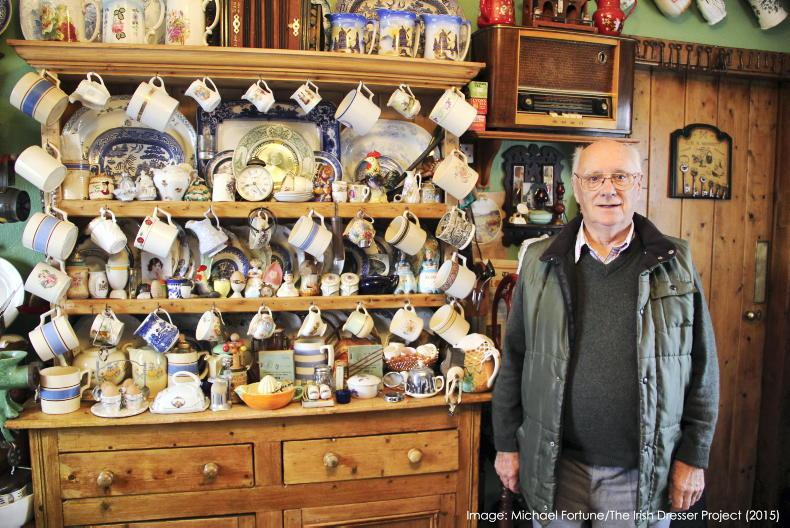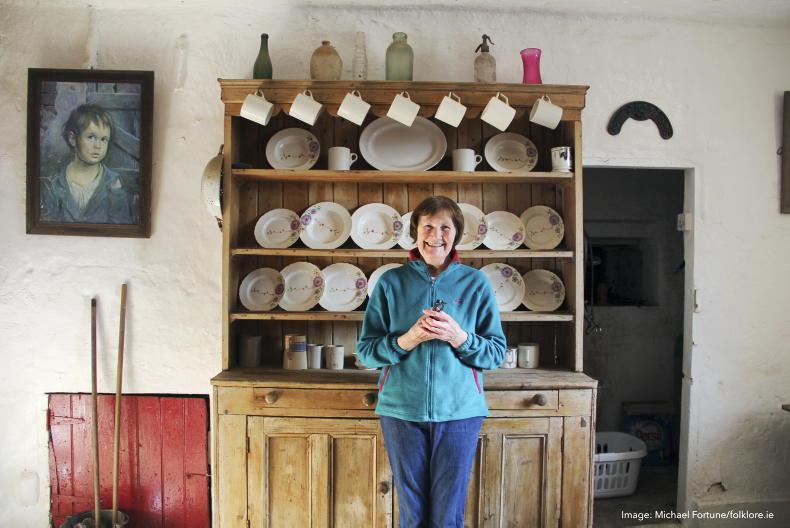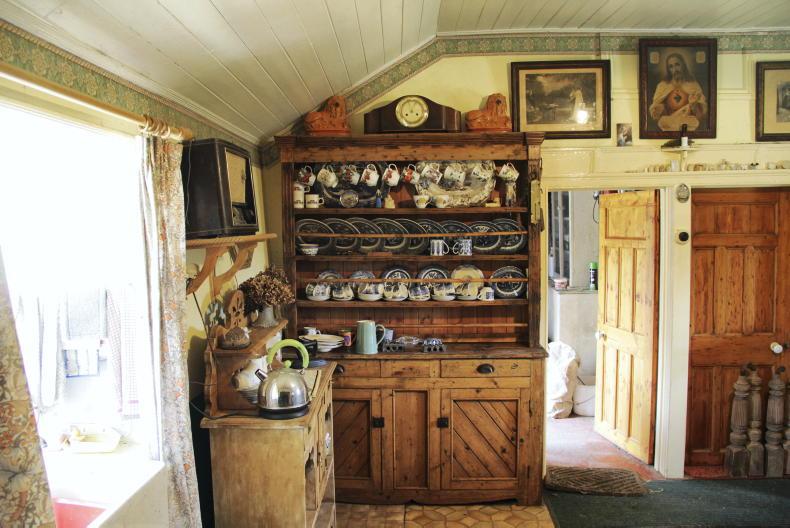Most will agree that from a technology point of view, modern kitchens are particularly impressive. Induction hobs heat up instantly, two-ovens is common place and presses, well, there’s more than the eye can see.
Traditional kitchens are also very impressive, but in a different way.
These centrepieces of the home are remarkable because of what they tell us about the people who inhabited them.

Peggy Murphy's dresser, Co Limerick.
The heart of every traditional kitchen was of course the dresser.
One man with a particular passion for dressers is Wexford native Michael Fortune. Having come through art college, Michael had an interest in photography and videography.
With this background and a keen interested in people also, Michael began documenting how people lived, their customs and associated folklore. An artist and a folklorist, he’s been doing this for over 20 years.
How dressers fit into all this, that came from his grandmother.
“The grandmother had the dresser at home,” Michael says. “I would have been photographing Granny’s dresser over the years. It was October 2014 she got bad health wise.

Jimmy Quinlan's dresser, Co Carlow.
“She was 102 at the time. She had a little two-up two-down house. She was going upstairs every night, a real steep stairs as well. Her legs went and she couldn’t get up the stairs. It kind of broke her heart a little bit.
“I remember a nurse coming out and saying, ‘You’re going to have to move the bed downstairs, you’re going to have to change the kitchen around and you’re going to have to move the dresser.’ To which the grandmother replied, ‘Like shite you’re going to touch my dresser.’”
Michael’s grandmother passed away some months later. It was then he decided to undertake a journey around the country documenting dressers; who made them, why were they made and why were they important in people’s lives?
A journey he’s still on
With his findings, Michael held exhibitions in several counties. Last year, Michael compiled these dressers and their stories into a calendar. With plenty of dressers to go around, just recently Michael launched his 2022 calendar.

Ann Conway's dresser, Co Wexford.
Each month has a picture of a different dresser, alongside the story of the dresser. Like all calendars it also marks important days. However, with his interest in folklore, these dates are slightly less conventional than most calendars.
“It marks things like when the swallows come and the cuckoo, dates to do with growing your spuds or cutting meadows. All those lovely little dates that are kind of important to us.”
Had by all
Interestingly, dressers were a feature right across the board and not just associated with a particular socio-economic status.
“The spread of people who had dressers was from the farm labouring classes, to the small farmers, to the big farmers and right up to the landed gentry,” Michael says. “They were important. The period I’m getting these in is from 1890-1940. Probably the 1920s/30s it was really popular.”
Through his work on dressers, Michael found common themes linking their owners.
“Loads of them were wedding presents. There was a tradition of men making dressers as a wedding present for their wives. That’s a lovely thing and I’ve come across that the length and breadth of the country.
“I have a Limerick dresser in the calendar this year and it was used for keeping a setting hen or a setting goose. You’ll talk to people and they’ll still remember having the setting hen inside. If you talked to people and told them you had a setting hen inside the kitchen today, they’d be going for the phone,” Michael laughs.
“This one in Limerick is lovely. It’s got four little hutches for the hens and geese to keep them away from Mr Fox, because they were valuable.”
For Michael, a project like this is not simply about kitchen units or even just their historical significance. He hopes it will give people an appreciation for the vernacular.
“I think there’s something inside us that will carry on the knowledge from the past. I certainly think it will be the case in rural communities and farming communities. I’m all for contemporary living and making life easier, but having that little grasp of the past is important. I think it settles us.”
For more see www.thedresserproject.ie or follow it on www.facebook.com/theirishdresserproject
In Michael’s opinion, there are two times in the year that are particularly important with regard to tradition, custom and folklore. Both relate to farming. May Eve traditionally marked the beginning of the growing season. The blessing of the land on May Eve is a common custom. October marked the end of the harvest. Here are two customs associated with these dates.
The May Bush
It is usually a slip of whitethorn or maybe a furze bush. You stick it up on top of a pile of dung. You decorate it with eggshells, ribbons and primroses. Mostly the young girls did it.
Ah Chailleach
Michael came across this tradition in Co Down. The last sheaf in the field, you bring it in, tie a knot in it and in some cases it was plaited. Like a St Brigid’s Cross it was hung up on the wall. There was good luck associated with it in having food over the winter. Then come the spring it was fed to the cattle.
As Gaeilge:
September is Meán Fómhair
October is Deireadh Fómhair
Meán Fómhair directly translated means middle harvest
Deireadh Fómhair means end of harvest
Read more
The dresser project
The wren, the wren, the king of all birds
The Biddy: A rural revival
Most will agree that from a technology point of view, modern kitchens are particularly impressive. Induction hobs heat up instantly, two-ovens is common place and presses, well, there’s more than the eye can see.
Traditional kitchens are also very impressive, but in a different way.
These centrepieces of the home are remarkable because of what they tell us about the people who inhabited them.

Peggy Murphy's dresser, Co Limerick.
The heart of every traditional kitchen was of course the dresser.
One man with a particular passion for dressers is Wexford native Michael Fortune. Having come through art college, Michael had an interest in photography and videography.
With this background and a keen interested in people also, Michael began documenting how people lived, their customs and associated folklore. An artist and a folklorist, he’s been doing this for over 20 years.
How dressers fit into all this, that came from his grandmother.
“The grandmother had the dresser at home,” Michael says. “I would have been photographing Granny’s dresser over the years. It was October 2014 she got bad health wise.

Jimmy Quinlan's dresser, Co Carlow.
“She was 102 at the time. She had a little two-up two-down house. She was going upstairs every night, a real steep stairs as well. Her legs went and she couldn’t get up the stairs. It kind of broke her heart a little bit.
“I remember a nurse coming out and saying, ‘You’re going to have to move the bed downstairs, you’re going to have to change the kitchen around and you’re going to have to move the dresser.’ To which the grandmother replied, ‘Like shite you’re going to touch my dresser.’”
Michael’s grandmother passed away some months later. It was then he decided to undertake a journey around the country documenting dressers; who made them, why were they made and why were they important in people’s lives?
A journey he’s still on
With his findings, Michael held exhibitions in several counties. Last year, Michael compiled these dressers and their stories into a calendar. With plenty of dressers to go around, just recently Michael launched his 2022 calendar.

Ann Conway's dresser, Co Wexford.
Each month has a picture of a different dresser, alongside the story of the dresser. Like all calendars it also marks important days. However, with his interest in folklore, these dates are slightly less conventional than most calendars.
“It marks things like when the swallows come and the cuckoo, dates to do with growing your spuds or cutting meadows. All those lovely little dates that are kind of important to us.”
Had by all
Interestingly, dressers were a feature right across the board and not just associated with a particular socio-economic status.
“The spread of people who had dressers was from the farm labouring classes, to the small farmers, to the big farmers and right up to the landed gentry,” Michael says. “They were important. The period I’m getting these in is from 1890-1940. Probably the 1920s/30s it was really popular.”
Through his work on dressers, Michael found common themes linking their owners.
“Loads of them were wedding presents. There was a tradition of men making dressers as a wedding present for their wives. That’s a lovely thing and I’ve come across that the length and breadth of the country.
“I have a Limerick dresser in the calendar this year and it was used for keeping a setting hen or a setting goose. You’ll talk to people and they’ll still remember having the setting hen inside. If you talked to people and told them you had a setting hen inside the kitchen today, they’d be going for the phone,” Michael laughs.
“This one in Limerick is lovely. It’s got four little hutches for the hens and geese to keep them away from Mr Fox, because they were valuable.”
For Michael, a project like this is not simply about kitchen units or even just their historical significance. He hopes it will give people an appreciation for the vernacular.
“I think there’s something inside us that will carry on the knowledge from the past. I certainly think it will be the case in rural communities and farming communities. I’m all for contemporary living and making life easier, but having that little grasp of the past is important. I think it settles us.”
For more see www.thedresserproject.ie or follow it on www.facebook.com/theirishdresserproject
In Michael’s opinion, there are two times in the year that are particularly important with regard to tradition, custom and folklore. Both relate to farming. May Eve traditionally marked the beginning of the growing season. The blessing of the land on May Eve is a common custom. October marked the end of the harvest. Here are two customs associated with these dates.
The May Bush
It is usually a slip of whitethorn or maybe a furze bush. You stick it up on top of a pile of dung. You decorate it with eggshells, ribbons and primroses. Mostly the young girls did it.
Ah Chailleach
Michael came across this tradition in Co Down. The last sheaf in the field, you bring it in, tie a knot in it and in some cases it was plaited. Like a St Brigid’s Cross it was hung up on the wall. There was good luck associated with it in having food over the winter. Then come the spring it was fed to the cattle.
As Gaeilge:
September is Meán Fómhair
October is Deireadh Fómhair
Meán Fómhair directly translated means middle harvest
Deireadh Fómhair means end of harvest
Read more
The dresser project
The wren, the wren, the king of all birds
The Biddy: A rural revival










 This is a subscriber-only article
This is a subscriber-only article









SHARING OPTIONS: